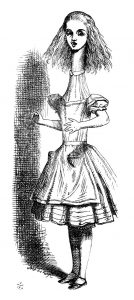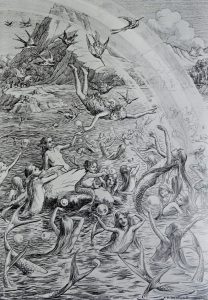In this blog, Jade Dillon discusses ideology of body symbolism related to girl characters in 19th century children’s literature. She interprets Carroll’s Alice and her growing and getting small within the context of the Victorian female ideal of a petite woman. She also looks at the contrasting female characters in Peter Pan and Wendy: Wendy, the kind motherly figure, and mermaids, the playful, seductive and dangerous other worldly females.
When I was analysing the word girl in ChiLit, I have noticed that the phrase little girl is strikingly frequent. The word girl is in nearly a third of its occurrences modified by little. And often that ‘little girl’ is also pretty and good. For ‘boys’, there is an entirely different story. The word boy is premodified by little in only 7% of its textual occurrences. Jade’s blog may give us some ideas as to why this is so. Enjoy reading!
Jade Dillon is a doctoral researcher and English tutor within the Department of English Language and Literature in Mary Immaculate College, Ireland. Jade’s thesis is entitled ‘Through the Looking Glass: Analysing Children’s Literature through the Theoretical Lens’. Jade’s most recent publication is to feature in ‘The Palgrave Handbook of Children’s Film and Television: Theory and Practice’ (2019) with Palgrave Macmillan. She was the co-organiser of ‘Mum’s The Word’ (a gender-based conference founded on the female experience in Popular Culture, 2017) and ‘Villainous Victims’ (a conference which focused on the demonization of the “Other” in the image of the anti-hero, 2018). Jade tweets from the account @jade_dillon.
***
“You!” said the Caterpillar contemptuously. “Who are you?”
– Alice’s Adventures in Wonderland (1865), Lewis Carroll
Children’s literature is an extremely didactic and ideological field of literary studies; the core function of my own research is to investigate the gender and ideological issues found within the genre of children’s fiction, whilst simultaneously exploring the intertextuality of the novels through film studies. Specifically, I examine the ideological implications and gendered identities in Alice’s Adventures in Wonderland, Through the Looking Glass, and What Alice Found There by Lewis Carroll and Peter Pan and Wendy by J. M. Barrie. My research deconstructs these narratives through gender theory, queer theory, psychoanalysis and intertextual cinematography. While these texts are rooted in the Victorian and Edwardian eras of British Literature, there have been many adaptations that recreate and appropriate the narrative trajectory and characterisations associated with the original texts. I have found that cultural discourse has a significant impact on the production of literature, so examining the differences between traditional and modern societies are fundamental to the story-telling of their literary constructions. Adaptation is a large part of my research; I examine the multi-platform storytelling of transmedia entertainment through cinematography and young adult novels.
Modes of Female Identity: Alice’s Adventures in Wonderland

Gender is a significant aspect of analyses in my research. The two modes of identity, the real and the symbolic, are displayed through the Victorian culture of London and the alternative universe: Wonderland and the Neverland. Female identity is altered when the protagonists enter into the alternative universe through a symbolic passageway, often a mirror which reflects the shift in their sense of ‘self’. The centrality of the child within the fantasy realm is deeply symbolic of psychological displacement. The reoccurring motifs of reality-infused fantasy are instrumental in children’s literature, particularly in Alice’s Adventures in Wonderland and Peter Pan and Wendy. Through the disparity of gendered identity and social construction, each protagonist illustrates a varying aspect of the Victorian mind and body. The resizing of Alice’s bodily form in Alice’s Adventures in Wonderland is deeply symbolic, as it echoes the obsession with the imperfection of the female body in Victorian society. As the embodiment of wife and mother, the female body was a preconceived notion of gendered ideals; thus, as Alice’s physical reshaping is analysed within the spectrum of feminist theory, Victorian stigmata are challenged. By altering her physical form to extreme limits, Carroll highlights both the perceived need to be physically accepted within a society, and also the feminist defiance of Alice. Of course, the prescriptive social gaze upon the female body is also a determining element of Alice’s physicality. Arguably, the female body in society is there to be viewed and admired by spectators, the woman does not own her body, and it is a social equity. As Alice’s physicality is continuously manipulated throughout the novel, Carroll is satirising the sexual and erotic nature of the female form within realist society. Regarding physicality and gender, Alice’s curiosity evokes risk and consequence, which ultimately begin to distort her bodily identity. Such distortion echoes that of the female figure in Victorian society who loses ownership of her physical form to societal notions:
‘Drink me…’ ‘I know something interesting is sure to happen,’ she said to herself, ‘whenever I eat or drink anything; so I’ll just see what this bottle does. I do hope it will make me grow large again, for really I’m quite tired of being such a tiny little thing’ (Carroll 1993: 60).
Smallness, daintiness and a petite form were all socially desired qualities for women in this period, so Alice’s expressed desire to grow large is an interesting voice of rebellion against these hegemonic norms.
Modes of Female Identity: Peter Pan and Wendy
Similarly, the female body is presented through opposing mediums within Peter Pan and Wendy. Wendy is the Victorian embodiment of female perfection, chastely poised and motherly. Wendy encapsulates the essence of womanly existence, as her childhood is marked by feminine progression, ‘but henceforth Wendy knew that she must grow up. You always know after you are two. Two is the beginning of the end’ (Barrie 2015: 1). Her maternal desire towards the lost boys of Neverland reinforces the argument that Victorian children were subjected to a very prescriptive societal ideology in relation to the notion of female perfection in terms of how society wanted women to behave, and the roles which it wanted them to fill, ‘Peter was bringing her to us… a lady to take care of us… pretty mother, pretty mother’ (Barrie 2015: 73-4). The chastity and virtue of women in the nineteenth century was a pivotal aspect of their characteristics, thus virginal attributions are accredited to Wendy’s demeanour throughout the text to reaffirm her Victorian perfection.

In stark contrast to Wendy’s virginal presence, the mermaids featured in Peter Pan are evocative, and greatly challenge the image of ‘traditional woman’. Mermaids evoke a sense of sexuality and alluring attraction, and their flirtatious behaviour echoes the historic origin of their mythological being. There are various folklore associations with the legend of mermaids, wherein ancient Greek mythology claims that mermaids could control the power of the sea, and were responsible for the vast amount of drownings and shipwrecks found on the coast. They believed the mermaids used their erotic bodies and song to lure handsome men to their deaths, and echoes of this are evident within the Barrie’s text. Examining F. D. Bedford’s original illustrations of Mermaid’s Lagoon, the exoticism of the female body is displayed. The mermaid’s delight in Peter’s soaring, and their overt feminine sexuality is evident in the aesthetic of the woman. The naked body and sweeping motions that are created through Bedford’s art mimics the fluidity of lust, thus echoing the seductive and alluring trance of the mermaids.
Overall, gender and social influences have a significant effect on the female characters of Carroll’s Alice’s Adventures in Wonderland and Barrie’s Peter Pan and Wendy. The rigid ideologies of the Victorian era are placed upon the protagonists and pressurise their sense of girlhood from the outset.
Primary Texts:
Barrie, J. (2015). Peter Pan. London: Puffin Classics.
Carroll, L. (1993). Alice’s Adventures in Wonderland and Through the Looking-Glass. Hertfordshire: Wordsworth Editions.
Please cite this blog post as follows: Dillon, J. (2019, 14th January). Exploring Female Identity in Carroll’s Wonderland and Barrie’s the Neverland [Blog post]. Retrieved from: https://blog.bham.ac.uk/glareproject/2019/01/14/exploring-female-identity-in-carrolls-wonderland-and-barries-the-neverland/
